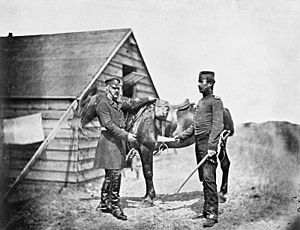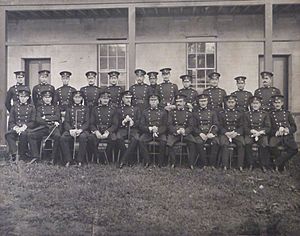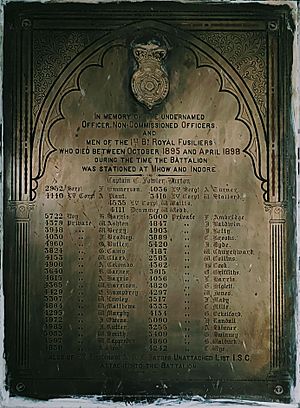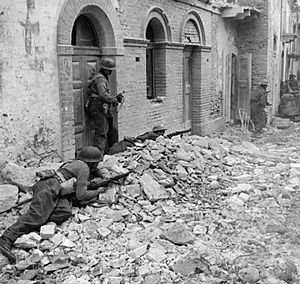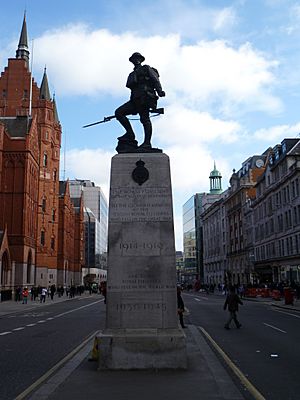Royal Fusiliers facts for kids
Quick facts for kids 7th Regiment of FootRoyal Fusiliers (City of London Regiment) |
|
|---|---|
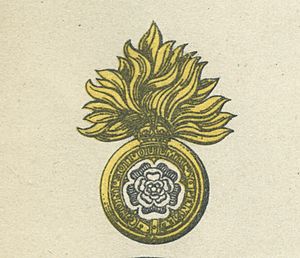
Cap badge
|
|
| Active | 1685–1968 |
| Country | |
| Branch | |
| Type | Infantry |
| Role | Line infantry |
| Size | 1–4 Regular battalions Up to 3 Militia and Special Reserve battalions |
| Garrison/HQ | Tower of London |
| Nickname(s) | The Elegant Extracts |
| Motto(s) | Honi soit qui mal y pense |
| March | The Seventh Royal Fusiliers |
| Insignia | |
| Hackle | White |
The Royal Fusiliers (City of London Regiment) was a famous line infantry regiment in the British Army. It existed for 283 years, from 1685 to 1968. Before 1881, it was known as the 7th Regiment of Foot.
This regiment fought in many important wars. These included the Second Boer War, the First World War, and the Second World War. In 1968, the Royal Fusiliers joined with three other regiments. These were the Royal Northumberland Fusiliers, the Royal Warwickshire Fusiliers, and the Lancashire Fusiliers. Together, they formed a new, larger regiment called the Royal Regiment of Fusiliers.
You can find a special monument, the Royal Fusiliers War Memorial, in Holborn in the City of London. It honors the nearly 22,000 Royal Fusiliers who lost their lives in the First World War.
Contents
- History of the Royal Fusiliers
- How the Regiment Started in 1685
- Fighting in the American War of Independence
- Napoleonic Wars and Other Conflicts
- Victorian and Edwardian Eras: A Growing Regiment
- The Royal Fusiliers in the First World War
- Russian Civil War Involvement
- The Royal Fusiliers in the Second World War
- Korean War Service
- The Amalgamation: A New Chapter
- Royal Fusiliers Museum
- Battle Honours: A Legacy of Courage
- Regimental Leaders: Colonels and Colonels-in-Chief
- Victoria Cross Heroes
- Images for kids
History of the Royal Fusiliers

How the Regiment Started in 1685
The Royal Fusiliers began in 1685. It was created by George Legge, 1st Baron Dartmouth. He took two companies from the Tower of London guard. At first, it was called the Ordnance Regiment.
Most soldiers at that time used matchlock muskets. But this new regiment used fusils, which were flintlock muskets. This was important because their job was to protect the artillery. Matchlocks had a burning wick, which could accidentally ignite the gunpowder barrels. Flintlocks were safer for this task.
The regiment went to Holland in 1689. They fought in the Nine Years' War at the Battle of Walcourt. They also fought in Flanders at the Battle of Steenkerque and the Battle of Landen. In 1695, they were part of the Siege of Namur.
In 1702, they helped capture Rota in Spain. They also saw action at the Battle of Vigo Bay during the War of the Spanish Succession. In 1751, the regiment officially became the 7th Regiment of Foot (Royal Fusiliers).
Fighting in the American War of Independence
The Royal Fusiliers were sent to Canada in 1773. Their soldiers were split into smaller groups. These groups served in places like Montreal and Quebec.
In 1775, American forces invaded Canada. A small group of 80 men from the regiment tried to defend Fort Chambly. They had to surrender, losing their regimental flags. Most of the regiment was captured when Fort St. Johns fell. However, a group of 70 men helped defend Quebec City in December 1775.
The captured soldiers were later released in New York City in 1776. The regiment was rebuilt there. They helped guard New York and New Jersey. In 1777, they took part in attacks on Fort Clinton and Fort Montgomery. They also destroyed enemy supplies.
In 1780, the Royal Fusiliers helped capture Charleston. After the city fell, they helped guard it. Some companies trained local Loyalist groups. A small group of 171 men fought at the Battle of Cowpens in January 1781. They were defeated, and their flags were captured again. The regiment returned to England in 1783.
Napoleonic Wars and Other Conflicts
The regiment went to Holland in 1807. They fought at the Battle of Copenhagen. Then, they went to the West Indies and helped capture Martinique in 1809.
Later that year, they served in the Peninsular War in Portugal. They fought in major battles like Battle of Talavera (1809) and Battle of Bussaco (1810). In 1811, they fought bravely at the Battle of Albuera.
They also took part in the Siege of Ciudad Rodrigo and the Siege of Badajoz in 1812. They fought at the Battle of Salamanca and the Battle of Vitoria in 1813. The regiment then chased the French army into France. They fought at the Battle of the Pyrenees, Battle of Orthez, and Battle of Toulouse.
In 1815, they went to Canada and helped capture Fort Bowyer during the War of 1812. A second battalion of the regiment was formed in 1804. It also fought in the Peninsular War and at the Battle of Albuera. This second battalion was later disbanded.
Victorian and Edwardian Eras: A Growing Regiment
In 1854, the regiment went to Scutari for the Crimean War. They fought in key battles like the Battle of Alma and the Battle of Inkerman. They also took part in the Siege of Sebastopol. After the war, they returned to Britain in 1856.
They were sent to India in 1857. They participated in the Ambela Campaign in 1863. The 1st Battalion served in various parts of India until 1901.
The newly re-formed 2nd Battalion went to Gibraltar in 1858. In 1866, they were sent to Canada to help stop the Fenian raids. They then went to India in 1873. They fought at the Battle of Kandahar during the Second Anglo-Afghan War.
In 1881, the regiment became officially known as The Royal Fusiliers (City of London Regiment). It already had two regular battalions, so it didn't need to merge with another regiment. It also had several other types of battalions:
- Regulars: The 1st and 2nd Battalions.
- Militia: These were local volunteer groups, like the 3rd, 4th, and 5th Battalions.
- Volunteer Infantry: These were also volunteer groups, like the 1st and 2nd Volunteer Battalions.
The 2nd regular battalion fought in the Second Boer War from 1899 to 1902 in South Africa. A 3rd regular battalion was formed in 1898. It served in places like Malta, Crete, Gibraltar, Egypt, and Sudan. From 1903 to 1905, it was part of the Bermuda Garrison. A 4th regular battalion was formed in 1900.
In 1908, the volunteer and militia groups were reorganized. The Royal Fusiliers then consisted of four regular battalions and three Special Reserve battalions.
The Royal Fusiliers in the First World War
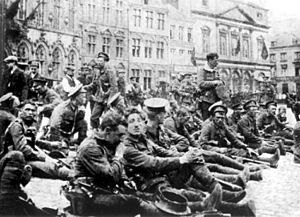
The First World War was a huge conflict. Many battalions of the Royal Fusiliers fought in it.
Regular Army Battalions in WWI
- The 1st Battalion went to the Western Front in France in September 1914. They fought in major battles like the Battle of the Somme and the Battle of Passchendaele.
- The 2nd Battalion landed at Gallipoli in April 1915. After being evacuated, they moved to Egypt and then to the Western Front. They also fought in the Battle of the Somme and the Battle of Arras.
- The 3rd Battalion arrived in France in January 1915. They fought in the Second Battle of Ypres and the Battle of Loos. They later moved to Egypt and then to Salonika.
- The 4th Battalion landed in France in August 1914. They were involved in some of the war's earliest battles, including the Battle of Mons and the Battle of Le Cateau. Two soldiers from this battalion, Lieutenant Maurice Dease and Private Sidney Godley, won the first two Victoria Crosses of the war near Mons.
New Armies and Volunteer Battalions

Many new battalions were formed during the war. These included "Service" battalions made up of volunteers.
- The 8th and 9th (Service) Battalions fought on the Western Front.
- The 10th (Service) Battalion was known as the Stock Exchange Battalion. It was formed by 1,600 members of the London Stock Exchange and others. Many of them were killed or went missing in action.
- Other battalions, like the 11th, 12th, 13th, and 17th (Service) Battalions, also fought on the Western Front.
- The 18th–21st (Service) Battalions were called the "Public Schools Battalions" because they were recruited from public schools. They also saw action on the Western Front.
- The 22nd (Service) Battalion was recruited from Kensington citizens.
- The 23rd and 24th (Service) Battalions were known as the "Sportsmen's Battalions." They were part of the "Pals battalions" where friends and colleagues joined up together.
- The 25th (Frontiersmen) Battalion served in East Africa.
- The 26th (Service) Battalion was recruited from the banking community.
- The 32nd (Service) Battalion came from East Ham.
- The 38th through 42nd Battalions formed the Jewish Legion in Palestine. Many of their members later helped create the State of Israel in 1948.
The Royal Fusiliers War Memorial stands on High Holborn in London. It has a statue of a First World War soldier on top. The regiment's special chapel is at St Sepulchre-without-Newgate.
Russian Civil War Involvement
The 45th and 46th Battalions of the Royal Fusiliers were part of the North Russia Relief Force. They arrived in Russia in early 1919. Their job was to help international forces leave Russia. These forces had been helping "White" (anti-Bolshevik) Russian groups during the Russian Civil War. The 45th Battalion had many former Australian soldiers who had volunteered to serve in Russia.
The Royal Fusiliers in the Second World War
The Royal Fusiliers played a big role in the Second World War.
- The 1st Battalion fought in the Italian Campaign for most of the war.
- The 2nd Battalion went to France in 1939 with the British Expeditionary Force (BEF). They fought in the Battle of France in May 1940. They had to retreat to Dunkirk and were then evacuated from France. Later, they fought in the Tunisia Campaign in North Africa. They also served in the Italian Campaign, including the tough Battle of Monte Cassino. They later fought in the Greek Civil War.
- The 8th and 9th Battalions were Territorial Army (TA) units. They fought in the final parts of the Tunisian campaign. In September 1943, they were heavily involved in the landings at Salerno in Italy. They also fought in the Battle of Monte Cassino and at the Anzio beachhead.
Other TA battalions, the 11th and 12th, were formed in 1939. They stayed in the United Kingdom for home defense. Many other battalions were also raised during the war. Some were changed into different types of units. For example, the 20th Battalion became a training unit in India for jungle warfare. The 21st and 23rd Battalions became part of the Reconnaissance Corps.
Korean War Service
In August 1952, the Royal Fusiliers, now with only one regular battalion, served in the Korean War. They were part of the 28th Commonwealth Infantry Brigade. Famous actor Michael Caine served with this battalion during the war. His unit often had to defend against Chinese attacks.
The Amalgamation: A New Chapter
On 23 April 1968, the Royal Fusiliers merged with three other historic regiments:
- The Royal Northumberland Fusiliers
- The Royal Warwickshire Fusiliers
- The Lancashire Fusiliers
Together, they formed the 3rd Battalion of the new Royal Regiment of Fusiliers. This marked the end of the Royal Fusiliers as a separate regiment.
Royal Fusiliers Museum
The Fusilier Museum is located at the Royal Regiment of Fusiliers Headquarters. This is inside HM Tower of London. The museum tells the story of the Royal Fusiliers. It also covers the history of six London Regiment battalions that were linked to the Royal Fusiliers before 1908.
Battle Honours: A Legacy of Courage
The regiment earned many "battle honours" for its bravery and service. These are special names of battles where the regiment fought with distinction.
- Earlier Wars: Namur 1695, Martinique 1809, Talavera, Busaco, Albuhera, Badajoz, Salamanca, Vittoria, Pyrenees, Orthes, Toulouse, Peninsula, Alma, Inkerman, Sevastopol, Kandahar 1880, Afghanistan 1879–80, Relief of Ladysmith, South Africa 1899–1902.
- The First World War: Mons, Le Cateau, Marne 1914, Aisne 1914, Ypres 1914 '15 '17 '18, Loos, Somme 1916 '18, Arras 1917 '18, Passchendaele, Cambrai 1917 '18, France and Flanders 1914–18, Gallipoli 1915–16, Palestine 1918, East Africa 1915–17.
- The Second World War: Dunkirk 1940, North-West Europe 1940, North Africa 1940 '43, Salerno, Anzio, Cassino II, Italy 1943–45, Athens, Greece 1944–45.
- Korea: Korea 1952–53.
Regimental Leaders: Colonels and Colonels-in-Chief
Colonels-in-Chief
These were important royal figures who held a special honorary position with the regiment:
- 1900–1937: King George V
- 1937–1942: Prince George, Duke of Kent
Colonels
The Colonels were the senior officers in charge of the regiment over the years:
- 1685–1689: Lieutenant-General George Legge, 1st Baron Dartmouth (the founder)
- 1689–1692: General John Churchill, 1st Duke of Marlborough
- 1789–1801: Field Marshal Prince Edward, Duke of Kent and Strathearn
- 1801–1832: Field Marshal Sir Alured Clarke
- 1963–1968: General Sir Kenneth Darling (who oversaw the merger)
Victoria Cross Heroes
The Victoria Cross (VC) is the highest military award for bravery in the United Kingdom. Many members of the Royal Fusiliers earned this incredible honor:
- Private Thomas Elsdon Ashford (1880, Second Afghan War)
- Lieutenant Maurice Dease (1914, First World War)
- Temp. Lieutenant-Colonel Neville Elliott-Cooper (1917, First World War)
- Captain Charles Fitzclarence (1899, Second Boer War)
- Assistant Surgeon Thomas Egerton Hale (1855, Crimean War)
- Lieutenant William Hope (1855, Crimean War)
- Private Mathew Hughes (1855, Crimean War)
- Captain Henry Mitchell Jones (1855, Crimean War)
- Temp. Captain Robert Gee (1917, First World War)
- Private Sidney Frank Godley (1914, First World War)
- Corporal George Jarratt (1917, First World War)
- Sergeant John Molyneux (1917, First World War)
- Private William Norman (1854, Crimean War)
- Lance-Sergeant Frederick William Palmer (1917, First World War)
- Sergeant Samuel George Pearse (1919, North Russia Relief Force)
- Lance-Corporal Charles Graham Robertson (1918, First World War)
- Acting Captain Walter Napleton Stone (1917, First World War)
- Corporal Arthur Percy Sullivan (1919, North Russia Relief Force)
Images for kids
-
Band of the 3rd Battalion of The Royal Fusiliers in Bermuda circa 1903, while the battalion was part of the Bermuda Garrison


